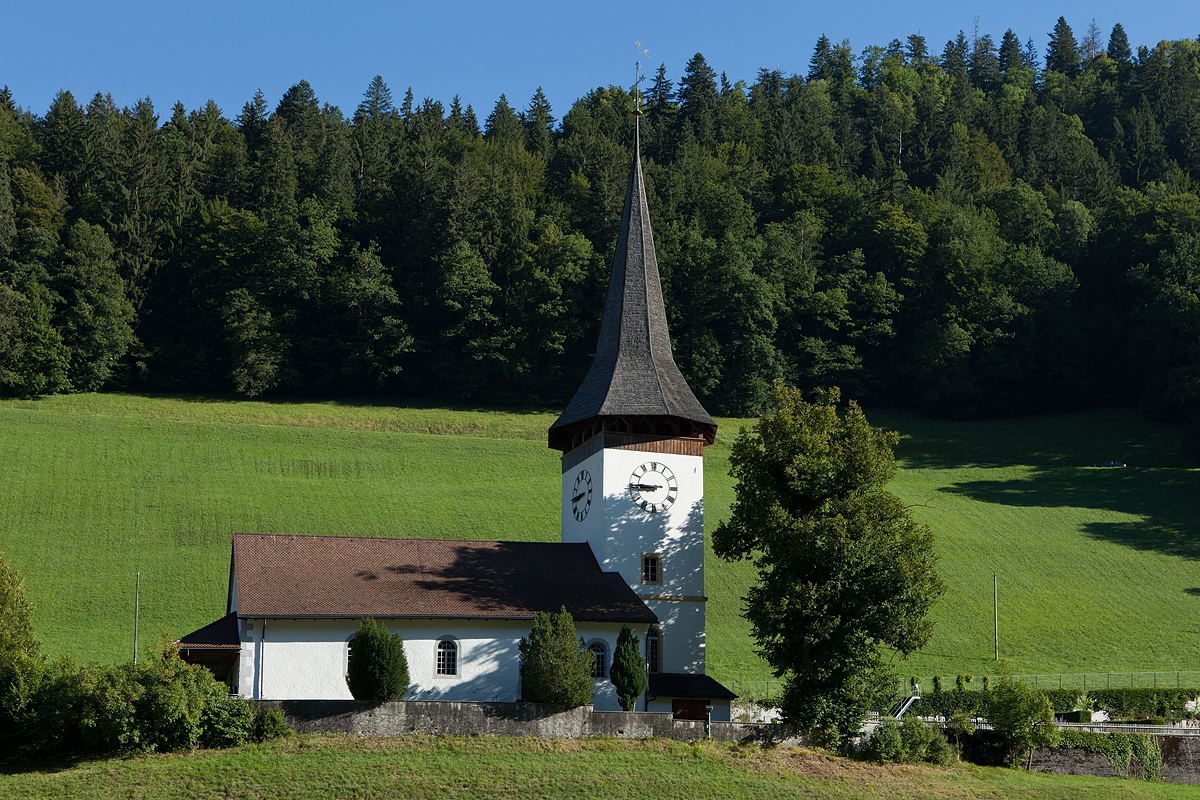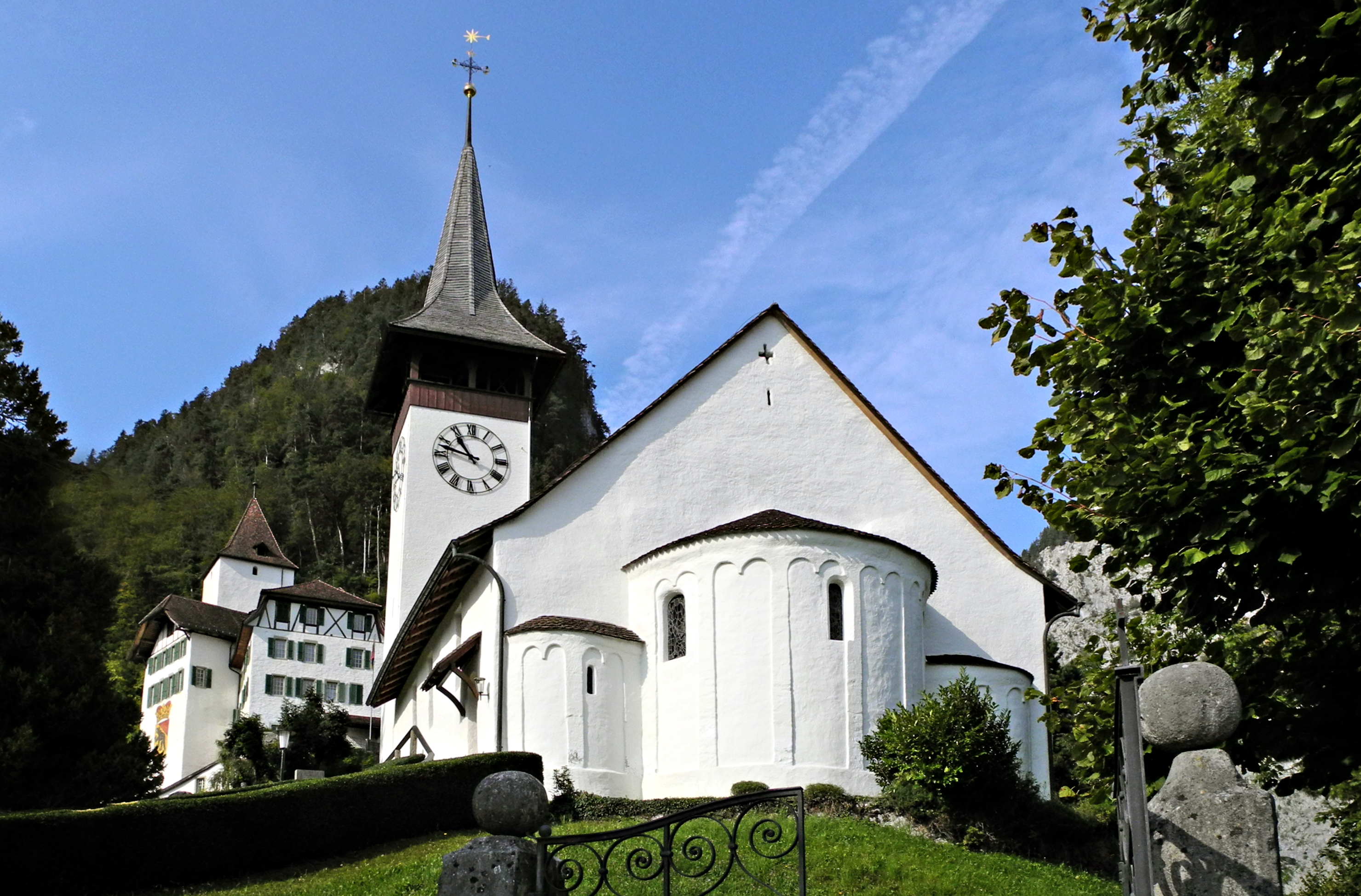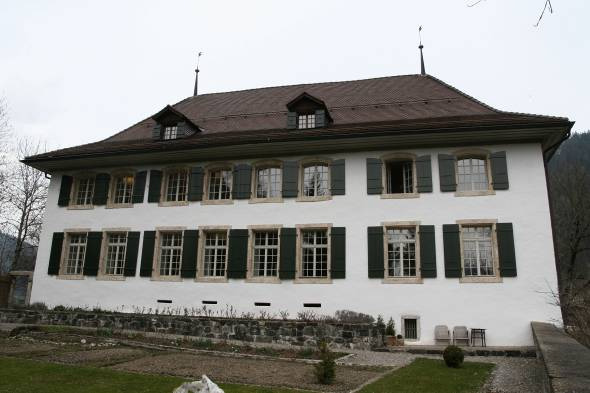|
Diemtigen
Diemtigen is a village and a municipality of the Frutigen-Niedersimmental administrative district in the canton of Bern in Switzerland. It is located at the northern end of the Diemtigtal elevated on a plateau west above the creek Chirel. In 1986, the community was awarded the Wakker Prize for preservation of its architectural heritage. History Diemtigen is first mentioned in 1257 as ''Diemtingen''. The Diemtigen area was inhabited during the Bronze Age and possibly during the Mesolithic Era. It was permanently inhabited and fortified by the High Middle Ages. The heights above the valleys are home to several castles or castle ruins. No records exist and very little is known about the ruins of Kronegg Castle, above Eggwald, and Grafenstein Castle, above Oey. The third castle, Hasenburg near Diemtigen was first mentioned in 1257 as castrum de Diemtingen and in the 12th and 13th centuries was the seat of the Freiherr von Strättligen. After the 12th century the castle ... [...More Info...] [...Related Items...] OR: [Wikipedia] [Google] [Baidu] |
Diemtigtal
Diemtigen is a village and a municipality of the Frutigen-Niedersimmental administrative district in the canton of Bern in Switzerland. It is located at the northern end of the Diemtigtal elevated on a plateau west above the creek Chirel. In 1986, the community was awarded the Wakker Prize for preservation of its architectural heritage. History Diemtigen is first mentioned in 1257 as ''Diemtingen''. The Diemtigen area was inhabited during the Bronze Age and possibly during the Mesolithic Era. It was permanently inhabited and fortified by the High Middle Ages. The heights above the valleys are home to several castles or castle ruins. No records exist and very little is known about the ruins of Kronegg Castle, above Eggwald, and Grafenstein Castle, above Oey. The third castle, Hasenburg near Diemtigen was first mentioned in 1257 as castrum de Diemtingen and in the 12th and 13th centuries was the seat of the Freiherr von Strättligen. After the 12th century the castl ... [...More Info...] [...Related Items...] OR: [Wikipedia] [Google] [Baidu] |
Frutigen-Niedersimmental (administrative District)
Frutigen-Niedersimmental District in the Canton of Bern The canton of Bern or Berne (german: Kanton Bern; rm, Chantun Berna; french: canton de Berne; it, Canton Berna) is one of the 26 cantons forming the Swiss Confederation. Its capital city, Bern, is also the ''de facto'' capital of Switzerland. ... was created on 1 January 2010. It is part of the Oberland administrative region. It contains 13 municipalities with an area of and a population () of 38,871. References {{coord, 46, 04, N, 7, 03, E, source:kolossus-eowiki, display=title Districts of the canton of Bern ... [...More Info...] [...Related Items...] OR: [Wikipedia] [Google] [Baidu] |
Boltigen
Boltigen is a municipality in the Obersimmental-Saanen administrative district in the canton of Bern in Switzerland. Boltigen is a mixed community, with traits both of a burgess community and a village community. Beside it, there is also a reformed evangelical Church community. The history of the community goes back to 1386 and the so-called ''Freiheitsbrief von 1386''. The community president is Hermann Maurer, since 1 January 2005. History Boltigen is first mentioned in 1276. The oldest trace of a settlement in the area is the mesolithic shelter in the ''Ranggiloch'' cave. A few Bronze Age artifacts have also been found. During the Middle Ages there were forts or castles at Simmenegg, Eichstalden and Laubegg though all three have fallen into ruin. Many of the villages and '' Bäuerten'' were founded in the Early Middle Ages and grew slowly over the following centuries. The villages and farm lands came under Bernese control partly in 1386 and completely in 1391. When B ... [...More Info...] [...Related Items...] OR: [Wikipedia] [Google] [Baidu] |
Sankt Stephan
St. Stephan is a municipality in the Obersimmental-Saanen administrative district in the canton of Bern in Switzerland. The namesake is the First Century martyr. History St. Stephan is first mentioned in 1352 as ''Sant Stephan''. The village grew out of a Burgundian royal estate located in a pass to Valais. In 994 it the royal family donated St. Stephan to Selz Abbey. Eventually the village became part of the lands of the Freiherr of Raron. In 1456 it passed to the Bubenberg family and then in 1494 was acquired by the city of Bern. The village church of St. Stephan was built in the Early Middle Ages. The original building was renovated and expanded in the 12th and 15th centuries. It was originally a filial church of the parish church in Zweisimmen. In 1335 Interlaken Abbey took over the patronage of St. Stephan. In the 15th century the residents began attempting to break away from the Abbey and form their own parish. Despite authorization from the Pope in 1430 ... [...More Info...] [...Related Items...] OR: [Wikipedia] [Google] [Baidu] |
Wakker Prize
The Wakker Prize (German: ''Wakkerpreis'', French: ''Prix Wakker'', Italian: ''Premio Wakker'') is awarded annually by the Swiss Heritage Society to a Municipality of Switzerland for the development and preservation of its architectural heritage. At the beginning, the prize honoured municipalities which did special needs for preservation of the old towns. Recently, the prize also honours municipalities that develop their townscapes on a specific leading point. This might be an estimated use of an old industrial facility or a successful combination between old and new basic structure of a building. In 2005, the prize was given to the Swiss Federal Railways, rather than a municipality, because of the jubilee of the Swiss Heritage Society. The prize is named for Henri-Louis Wakker Henri-Louis Wakker (18 March 1875 – 17 March 1972) was a Swiss people, Swiss banker and real estate entrepreneur. His will provided a considerable sum of money without conditions to the Swiss Her ... [...More Info...] [...Related Items...] OR: [Wikipedia] [Google] [Baidu] |
Adelboden
, neighboring_municipalities= Diemtigen, Frutigen, Kandersteg, Lenk im Simmental, Leukerbad (VS), Sankt Stephan , twintowns= } Adelboden is a mountain village and a municipality in Switzerland, located in the Frutigen-Niedersimmental administrative district in the Bernese Highlands. Geography Adelboden lies in the west of the Bernese Highlands, at the end of the valley of the river Entschlige (High German: ''Engstlige''), which flows in Frutigen into the Kander. Adelboden is a traditional Swiss mountain village on a terrace looking south to the Engstligen waterfalls. Also part of the village are the inhabited valleys of Gilbach, Stigelschwand, Boden, Hirzboden, and Ausserschwand. Church and main street are at , the highest point of the area is the Grossstrubel with , the lowest point is at in the Engstligen valley. The vegetation is alpine and sub-alpine, partially wooded, the slopes, the plateaus, and terraces usually alp meadows. The most salient mountains a ... [...More Info...] [...Related Items...] OR: [Wikipedia] [Google] [Baidu] |
Wimmis
Wimmis is a municipality in the Frutigen-Niedersimmental administrative district in the canton of Bern in Switzerland. History Wimmis is first mentioned in 994 as ''Windemis''. The oldest traces of a settlement in Wimmis include the Mesolithic and Bronze Age settlements on the Chienberg and the Bronze Age and High Middle Ages settlements on the Pintel. Roman era artifacts were found at Engfeld and bronze statue of Emperor Gordian III was found at Tägerstein. The area remained inhabited during the Middle Ages and in 994 King Otto III granted his estates in Wimmis to Selz Abbey. By the 12th or 13th century the Lords of Wimmis or Strättligen built Wimmis Castle above the village. The exact relationship between the two families is unclear, but the Wimmis line became extinct in the mid-13th century and by 1260 the Freiherr von Strättligen owned Wimmis Castle and the surrounding lands. A few years later the castle and lands were incorporated into the extensive holdings of ... [...More Info...] [...Related Items...] OR: [Wikipedia] [Google] [Baidu] |
Zweisimmen
Zweisimmen is a municipality in the Obersimmental-Saanen administrative district in the canton of Bern in Switzerland. History Zweisimmen is first mentioned in 1228 as ''Duessimenes''. In 1257 it was mentioned as ''Zweinlixhenun''. The oldest trace of a settlement in the area are some scattered mesolithic artifacts from Mannenberg-Riedli. The remains of a Roman era settlement were found at Mannried. During the Middle Ages a significant trade route over the Alps to Valais and Lake Geneva passed through the Zweisimmen region. A number of farming villages probably existed in the area during the Middle Ages. In the 13th and 14th centuries, local nobles built several castles, Upper Mannenberg and Lower Mannenberg, Reichenstein-Terenstein, Blankenburg and Steinegg Castles, to protect and collect taxes from the roads. The villages and castles passed through several noble families until 1378 when the Lord of Düdingen sold the lands to Fribourg following an uprising. After t ... [...More Info...] [...Related Items...] OR: [Wikipedia] [Google] [Baidu] |
Reichenbach Im Kandertal
Reichenbach im Kandertal is a village and municipality in the Frutigen-Niedersimmental administrative district in the canton of Bern in Switzerland. Until 1957 it was known as Reichenbach bei Frutigen. Besides the village of Reichenbach, the municipality includes several other settlements, including Aris, Faltsche, Griesalp, Kien, Kiental, Ramslauenen, Reudlen, Scharnachtal, Schwandi and Wengi. Additionally, the village of Mülenen is shared between Reichenbach and Aeschi bei Spiez municipalities. The area played a notable role in world history when the Kienthal Conference was held at Kiental (then known as Kienthal) in 1916. The blazon of the municipal coat of arms is ''Argent a Bear Paw issuant from a Mount of 3 Coupeaux Vert.'' History Reichenbach im Kandertal is first mentioned about 1320 as ''Richenbach''. During the Middle Ages, the village occupied a strategic location on the trade route into the Canton of Valais. Two castles, Mülenen Castle, with the Letzi Mül ... [...More Info...] [...Related Items...] OR: [Wikipedia] [Google] [Baidu] |
Oberwil Im Simmental
Oberwil im Simmental is a municipality in the Frutigen-Niedersimmental administrative district in the canton of Bern in Switzerland. History Oberwil is first mentioned in 1278 as ''Oberwile''. During the Paleolithic era (20,000-10,000 BC) humans lived in several caves above the valley floor during the summer. The caves, Schnurenloch, Mamilchloch, Zwergliloch and Chniechälebalm, contained about 5,000 bones from the now extinct cave bear which the inhabitants had butchered. While no human remains were discovered, a number of stone tools were found. Today the tools and bones are at the Historical Museum of Bern while the caves can be visited with tour groups. These caves and other nearby rock shelters continued to be used through the Neolithic, the late Bronze Age and into the Middle Ages. After the collapse of the Western Roman Empire, Alamanni tribes settled in the Simmen valley and established villages and alpine pastures. In 994, the royal estate at Wimmis and part of O ... [...More Info...] [...Related Items...] OR: [Wikipedia] [Google] [Baidu] |
Frutigen
Frutigen is a municipality in the Bernese Oberland in the canton of Bern in Switzerland. It is the capital of the Frutigen-Niedersimmental administrative district. History The area around Frutigen may have been settled since possibly the Bronze Age or Roman times. It is first mentioned in 1234 as ''Frutingen''. During the Middle Ages there were three castles in the modern municipal border; Halten, Tellenburg and Bürg. By 1260 the scattered farmers of the valley floor had formed a political and business association. The association had its own seal in 1263 and in 1340 it negotiated a peace with an association in the Obersimmental. In 1391, the village of Frutigen gained the right to hold the low court in the village. In 1400, the expanding city-state of Bern annexed the entire valley. However, the association was powerful enough to force Bern to make concessions. The residents of the valley were freed from the obligation to pay taxes or provide labor for local ... [...More Info...] [...Related Items...] OR: [Wikipedia] [Google] [Baidu] |
Erlenbach Im Simmental
Erlenbach im Simmental is a municipality in the district of Niedersimmental in the canton of Bern in Switzerland. History Erlenbach im Simmental is first mentioned in 1180-81 as ''Arlunbach''. The oldest trace of humans in the area is the Paleolithic Chilchlihöhle cave. Neolithic remains have been discovered at Branteschopf Schwynbalm. Other prehistoric traces include the Bronze Age and Roman era artifacts at Balzenberg and Unterklusi and a horde of Roman coins at Stockhorn. After the Fall of the Western Roman Empire, the region remained inhabited. The earthen fortification at Chastel probably dates to the Middle Ages. By the High Middle Ages there were at least three castles or forts in the modern municipality, though only ruins remain. The Freiherr von Erlenbach first appears in records in 1133. When the Erlenbach family died out, their lands probably passed through another noble family before ending up with the Freiherr von Brandis in 1368. Beginning in the 14th c ... [...More Info...] [...Related Items...] OR: [Wikipedia] [Google] [Baidu] |










